Trangia 25 Stove review
Trangia Gas Burner review
Optimus Nova+ Multi-fuel Burner review
Trangia branded Multi-fuel Burner review
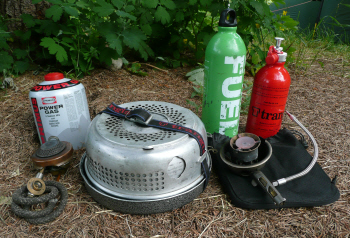
Complete cooking kit – Trangia Gas Burner, Stove & Multi-fuel Burner
Trangia 25
We’ve used a Trangia for years. There are lighter, smaller stoves around, but the Trangia set gives a lovely stable base, with a built-in wind shield, and the two pots, frying pan and kettle all pack away into the base and windshield (along with herbs, spices, salt & pepper, lighter and spoons) and the whole package takes up about the same space as a normal cooking pot. The Trangia set comes with a meths burner, which we have long since discarded as it was slow and very difficult to regulate. But with the right burner, Trangia cooking systems are just brilliant. They are always stable and the pot has never accidentally slipped off the side of the stand (as I have seen happen all too often with other stoves) as the pot sits deep within the windshield held securely on shaped pan-supports. Even when using the frying pan, which sits high above the flame on the upturned pan-supports, the shaped supports hold it firmly in place. The two pots are more than big enough to make a good sized meal for 2 hungry cycle-tourists and have been used to feed 3 on more than one occasion. The little kettle actually holds one litre and the frying pan is normally used as a lid over the pot and this also improves performance as very little heat escapes.
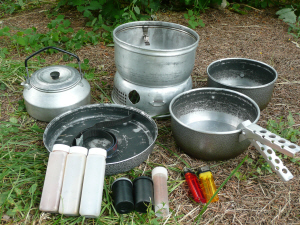
All of this …
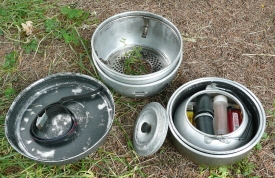
… packed like this …
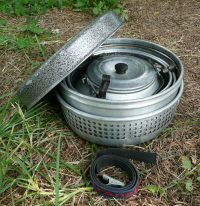
… fits into this!
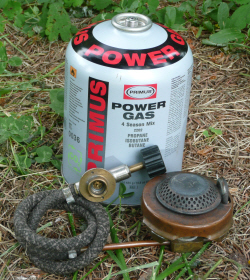
Gas Burner & 500ml gas
The Trangia gas burner is bought as a separate item from the main unit – our gas burner is more than 15 years old and works as perfectly as the day it was bought.
Up until last year (2011) the gas burner was the only burner we used with our Trangia. It is a neat, tidy and robust unit, but when packing it away, you should position it carefully so that its square & sharp edges don’t puncture something else in your pannier or rucksack. The picture of the burner & gas-canister, show the large-size canister – 500ml (approx). The gas canisters come in 3 different sizes – 125ml, 250ml & 500ml – but to double the size, actually gives you much more than twice the amount of fuel. A 125ml canister will be enough for 2 or 3 meals; a 250ml canister would last us about 5 to 7 days, while a 500ml canister will last us nearly 3 weeks (having a kettle full of hot water with breakfast and cooking rice or pasta and a main-course in the evening every day). The gas is easy to get hold of in the UK in basically any camping shop, but finding it abroad can sometimes prove more difficult, or as difficult as it is to find any camping shop.
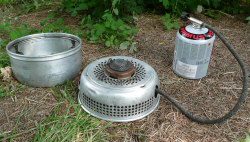
Gas burner in Trangia base with upper windshield beside
Pros
– Easy to light (sparks off a flint cigarette-lighter are enough)
– No pre-heating required – full working temperature available practically straight away
– Very controllable heat range, and a good low simmer point
– Very clean fuel – absolutely no sooty deposits anywhere
– No jumping big yellow flames, always just a tight blue flame down on the burner
– To pack away, just unscrew from the gas, and pack – no fuel-pipe to be emptied
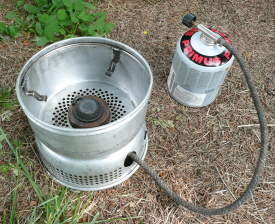
Trangia with Upper windshield fitted & pot-stands visible
Cons
– Gas can be hard to find and in some countries, gas will not be available, so not a global solution
– Gas cannot be taken on board any flight so if flying on holidays, you must first find gas on arrival
– Gas is actually quite expensive when compared against liquid fuel options – 500ml canister is about 8 to 10 Euros (giving approx 3 weeks cooking)
Optimus Nova+ Multi-fuel Burner
We bought this burner before setting off on our 2011 cycle-tour (read blog for that trip here) with the intention of using it whenever we were unable to find gas. We chose the Optimus Nova + as it’s possible to buy an attachment to allow you to fit it into the Trangia base. We’d also read a load of good reviews about it.
Sadly our experience was somewhat different to the experience of other reviewers. The Nova worked reasonably well for the first couple of uses, but after that it became increasingly difficult to light, and, once lit, would sputter and pulse, and the flame would go out every few minutes.
We stripped, cleaned and lubed everything, but saw no improvement. We wondered if it was the fuel we were using (98% paraffin) and switched to unleaded petrol. Still no improvement. We took the filter out and it worked a bit more reliably, but running it without a filter clearly wasn’t going to be a good long-term solution.
After some further, frustrated rummaging around the internet we discovered to our annoyance that our pre-purchase research on multi-fuel stoves had missed the bit about Optimus being taken over by Katadyn and the quality of their stoves taking a nose-dive. Reviewers reported that the Katadyn-era stoves are unreliable and not a patch on the originals, so we’ve now given up on the Nova + and replaced it with a Trangia-branded multi-fuel burner.
Pros
– Came with a neat zipped canvas pouch complete with funnel, spares & tool
Cons
– Badly designed adaptor to make the burner fit into Trangia base … badly
– Position of fuel regulator on the fuel-pipe meant that it was necessary to have the Trangia base, and the fuel bottle sitting at the exact same level, with the fuel pipe running as straight as possible between the two but the fuel pipe was quite long, so this was a pain
– Difficult to light
– Would continuously cough & splutter and then put itself out and need to be relit as quickly as possible to avoid the fuel smell and the need to pre-heat all over again
– Didn’t work
Trangia-branded Multi-fuel Burner
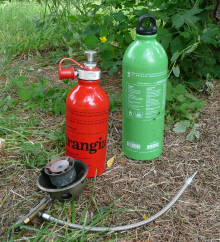
Trangia multi-fuel burner with 2 fuel bottles
We bought this burner just before setting off this year (2012). We got a reasonable deal from the retailer as it was old stock and they no longer listed the item and this one had been knocking around their distribution network for over a year. So although a very recent purchase, it does differ in specification from the current multi-fuel burner being marketed by Trangia. This one was actually made by Optimus, but we’re pretty sure it was made in the pre-Katadyn days (see note about Optimus Nova+ above).
On one particular afternoon at the end of May in eastern Germany, when our 1st gas canister was nearly finished, we spent far too long checking every likely shop in every town & village that our route took us though for a new gas but failed to find one. So the next day, when we were in the supermarket, we decided to buy a bottle of barbeque lighter fluid for our new multi-fuel burner. Although multi-fuel burners can burn unleaded petrol, manufacturers recommend that you don’t burn it too often as it is full of additives which can block your burner’s jets. Meanwhile barbeque lighter fluid is low odour, not as explosive as petrol and yet is petrol based (rather than alcohol based), so we decided to give it a try and that’s what we’ve been using ever since (apart from a few wet days where we used a gas that we bought about a week later). The lighter fluid is working well and at this time of year, is very easy to find in the supermarkets and relatively cheap – 1 litre costs between 1 & 2 Euros and will last about the same length of time as the 500ml gas, between 2 & 3 weeks. We had just crossed into Poland when we bought the lighter fluid and so couldn’t read the information on the bottle, but we think it is paraffin based.
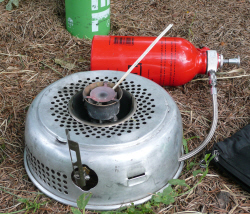
Lighting the multi-fuel burner with a long wooden taper
Lighting a multi-fuel burner is something that needs to be practiced, and the behaviour of the burner will differ with different fuels. So far, we’ve only been using the barbeque lighter fluid and I can now nearly always light it without any jumping yellow flames or flares, but as a result of this potential behaviour, it should not be lit anywhere close to the tent. To light the burner, first I release about 5 seconds worth of fuel and also try to get some of the fuel onto a long cardboard or wooden taper (you could always buy long matches, but we haven’t). Light the taper with your cigarette lighter and then use that to reach down into the lowest part of the burner to light the pre-heating pad. This will then burn the fuel you released earlier, but the flame at this point is a very sooty yellow flame, so it is best to do the pre-heating with the upper half of the Trangia stand removed to avoid coating the whole thing in a thick layer of black. As the released fuel burns off, just as the flame dies down, you can then start to open the valve slowly and it is ready for cooking.
When you get to the end of cooking, you need to empty the fuel pipe before you can disconnect the fuel bottle and this can take a further 2 minutes of cooking. This can be done quite easily when you are only boiling water as you just add a further 150ml of water to the kettle and roll the bottle to the off position, but it is a bit more difficult to predict when you want to switch off when you are cooking a meal.
Pros
– Cheap fuel (1 to 2 Euros buys 1 litre of barbeque lighter fluid (giving approx 3 weeks cooking)
– Wide variety of possible fuels making it easy to find something that will work
– Burner fits firmly and easily into Trangia base as it is well designed for this
– Good controllable heat range, but simmer point is not as low as with gas burner
– Fuel pipe is short, so the fuel bottle is not too far from the unit
– Valve for fuel outlet, is at the stove-end so easy to use (easier than Optimus Nova+)
Cons
– Can be a fiddle to light (but experience helps)
– Pre-heating can be a pain but should only take 2 to 3 minutes
– You can’t switch off mid-cooking and then fire it up again a few minutes later without needing to pre-heat again
– Yellow flames are full of soot and if you let it touch anything, it will be covered
– Until you are familiar with the burner & fuel, you will have big yellow flames from time to time during pre-heating
– You can’t just switch off and pack away, you must first empty to fuel pipe
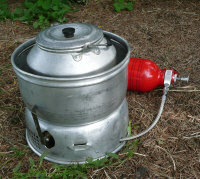
Trangia with kettle & multi-fuel burner, with control valve at the front
We currently use the multi-fuel burner most days, mainly as it’s cheaper but also because it’s working easily & reliably, so there’s no need to use up the gas which is just time consuming to find a replacement for. I’m sure if we look hard enough in any city, we will manage to find a good camping shop with camping gas, but it’s the time needed to do this that puts you off. So we are currently travelling with an almost full gas, plus liquid fuel and the gas will get used when it rains and we want to cook inside the vestibule of the tent. We also have 2 fuel bottles, one for attaching to the stove and one for carrying up to 1 litre of spare fuel. When using fluid, you cannot fill to full the fuel bottle, you must leave space to enable you to pressurise the vessel, but that means topping it up can be troublesome if you only have one bottle, thus carrying a litre bottle for spare fuel and then a 500ml bottle for attaching to the stove, works well, as about 4 or 5 days after the big bottle gets emptied, you then start to think about buying some more.
We’re pleased with the performance of the Trangia burner and are glad we bought it.

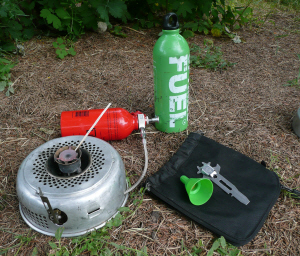
Thanks for the review. We have a Trangia that we bought over 35 years ago that doesn’t have a hole for the fuel tube to exit but my son does. He has what I think is this same burner as you. We use an Optimus multifuel stove . I tried paraffin but it burned very sooty and needed frequent cleaning. I prefer to use Coleman fuel(white gas) as I don’t get the leaping yellow flames. If its really rainy and I cook in the tent, then I change the little nut with a hole ( cannot remember the name of the part) which regulates the amount of fuel coming through as I feel it is safer.
Glad your knee is getting better. Don’t stress yourself too much.
Brenda in the Boro UK
Hello Brenda, Thanks for reading our blog, and even our kit reviews – much appreciated. As for my knee, it gets a little bit better each day … I think!
Thanks again,
Keith.